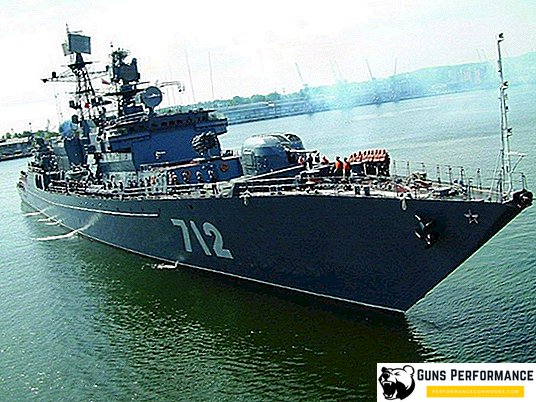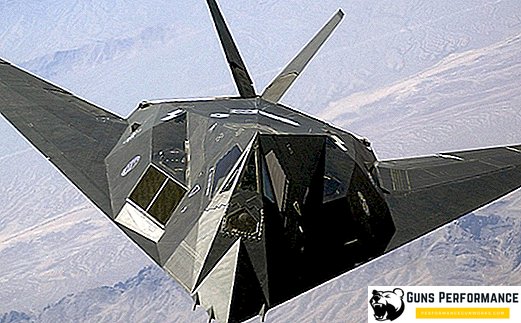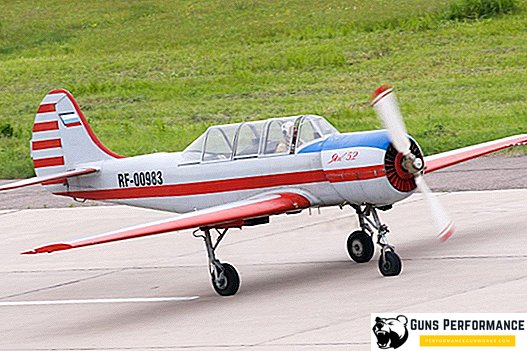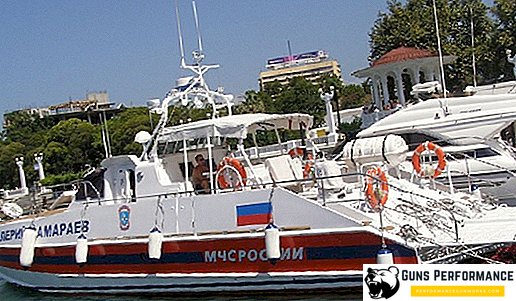In the history of the Russian Navy one of the leading places is occupied by the combat service of patrol ships. This type of warship is considered the most massive in the fleet. The range of tasks performed by ships of this class is also enormous. Storozheviki always been at the forefront, protecting the safety of maritime communications and maritime borders of our country.

In the Soviet Union, the agenda was a naval strategy providing for active defense of our own sea frontiers. For this purpose, the guardians, who were mainly used for the defense of coastal waters, were best suited. To perform combat missions, the ships did not require any greater autonomy of navigation, nor powerful weapons. However, the appearance in the sea of a large number of strike formations of the American fleet and ships of the NATO countries, forced the Soviet naval command to look for new technical means of struggle. The response to the strengthening of the naval power of a potential enemy should have been the patrol ships of the project 11540.
The main objectives of the new patrol Yaroslav wise and Fearless
The new patrol, which was planned to be transferred to the Baltic Fleet, were to become the strongest and most powerful ships on the Baltic Sea Theater. The main goal that was set for them was to control the Baltic Sea. It was not excluded that the outrigger would enter the ocean to ensure the safety of navigation and intercept enemy ships on long-range borders.
The goals required an increase in the size and displacement of warships. It was necessary to create a patrol ship capable of being at sea for a long time and which would have superior firepower. The ships of the previous project 1135 clearly demonstrated the design features of the guard ships of a new type, which needed to be either improved or modernized. The introduction of a number of technical innovations into the project and the increase in the ship’s displacement have led to the transition of project 11540 ships to the frigate class.

The technical assignment for the construction of new patrol arrived in 1981. The developer of the project documentation was Zelenodolsk PKB. At that time, the shipbuilding capacities of the Soviet Union made it possible to build large quantities of warships with a displacement of up to 4 thousand tons. The patrol ship of the new project was to be built taking into account all the design features and innovations possessed by the same type vessels in foreign fleets. The American frigate of the Oliver Perry type and the German ship of the Bremen type were chosen as a reference point. In its final form, the project 11540 received the code "Hawk". According to the NATO classification, the new patrol was considered a frigate, i.e. multipurpose warships of long range.
The new combat units after the entry into service were supposed to replace the project 1135 sentry on duty. The shoulders of the frigates of the "Hawk" type were assigned to search for enemy submarines and destroy them. The presence of powerful anti-ship armament and air defense systems ensured the following tasks for new ships:
- the implementation of the protection of maritime communications;
- antisubmarine defense and long-distance patrols;
- the implementation of attacks on coastal sites;
- ground support during landing operations.
As part of the fleet's operational formations, the frigates of the project 11540 were to ensure the protection of the marching order from the strikes of ships and submarines of the likely enemy.
Design features of the TFR project 1540
The patrol ship, built by Soviet shipbuilders at the Yantar shipyard in Kaliningrad, was a logical continuation of the project 1135 TFR, which successfully served in various maritime theaters. The new ship was to become a universal combat ship, capable of simultaneously performing both guard and offensive functions. The main design feature of the new ship is the use of materials with a weak reflective surface in the construction of the ship.

The first ship of the type "Hawk" series of three ships laid in 1987.
For reference: it was originally planned that ships of this type will be the most massive in the Soviet Navy. Plans envisaged the construction of 70 ships over 10 years. For this purpose, the capacity of 7 shipbuilding enterprises of the country should be used.
The ship received the factory number 401 and a year later, in May 1988, it was launched. Over the next two years, the ship was completed, including the installation of weapons and equipment of the vessel with the main components and assemblies. In December 1990, the new guard came into operation. The combat service of the ship under the name Fearless in the composition of the Baltic Fleet began in the spring of 1991.
The second ship of the series with the serial number 402 under the name "Impermeable" did not have time to enter service. Founded in 1988, it was launched in 1990, however, due to the collapse of the Soviet Union, the construction and finishing of the ship was delayed for 19 years. Only in 2009, the construction was finally completed, and the ship entered service of the Baltic Fleet, receiving the resounding name Yaroslav the Wise.
The third ship, which had the name "Fog" was laid in 1993, but the lack of funding for construction led to the fact that the ship was never completed. In 2018, it was decided to dispose of the unfinished hull of the vessel.
New ships such as "Hawk" featured an increased displacement. In accordance with the project documentation, the frigate was supposed to have a nominal displacement of 3.5 thousand tons. The “Fearless” TFR, launched in 1990, had a length of 117 meters on the waterline and 14 meters width. The ship's displacement corresponded to the parameters of the project 1135 sentrymen. The cost of building a new frigate was 80 million rubles (1988 prices).
For the first time in the Soviet fleet, new technologies were applied on the vessel, which were aimed at reducing the noise level of the operating propellers and at increasing the ship's navigability. At the design stage, changes were made to the project regarding the power plant, the types and quantity of the ship’s weapons, the layout of the main units. The main changes made to the project led to the creation of ships of modification 11541 of the type "Corsair", calculated as an export option.
Ship hull and power plant
The hull of the lead ship had 12 compartments and an elongated forecastle, was made of steel. In the design of the case, a bulb is installed on the nose, in which the sonar station is located. Innovation can be considered stabilizers pitching and installed on the side cheekbones extra keels. The ship was equipped with the necessary devices and devices for refueling and receiving cargo from support vessels directly at sea.
The hull design was created in such a way that when the three adjacent compartments were flooded, the ship retained its buoyancy and stability.

Characteristic distinctive external signs of the ships of the type "Hawk" were two masts and two chimneys. The main control units and life support units were concentrated in four separate strongholds. The upper superstructures of the ship, as already mentioned, had a special tilt angle of 8-100, which significantly reduced the reflectivity of the ship under the influence of radar waves.
It was planned to equip all the sentry-guard with four gas-turbine engines. Two engine units of the M-70 design ensured marching speed for the sentry-guard, while the other two engines of the M-90 type could provide the ship’s movements on the shaped course. The main power plant was divided into two independent groups. Close to the nose of the patrol housed propulsion engines. More powerful, high-speed engines were placed closer to the stern of the ship. Such an arrangement of the motor group significantly increased the survivability of the ship, ensuring its progress even with critical injuries. The power of the main engines was 37 thousand hp With the engines of the afterburner group turned on, the total power of the power plant reached 55-57 thousand hp.
The operation of the power plant provided the ship with an economical course at a speed of 18 knots. With a working afterburner group, the ship could reach a maximum speed of up to 31 knots. Moving in an economical course, the new patrolman had a cruising range of 3.5 thousand miles. The vessel could continuously be at sea for up to 30 days. The crew of the ship on the state of the combat schedule was 214 sailors and officers.
Armament of patrol ships of the project 11540
Initially, the ships of the project 11540 planned to arm only anti-submarine and artillery weapons. The first ship of the series, frigate Fearless, was armed only with mine and artillery weapons, mainly designed to fight enemy submarines. Missile and anti-submarine complex "Waterfall" was a system capable of firing, both torpedoes and anti-submarine missiles at a distance of 120 km. Anti-submarine warfare was to be conducted with the help of the RBU-6000 Smerch-2, a multi-barreled jet bomb.

The AK-100 semi-automatic artillery gun was installed on the main deck in the forecastle area as an auxiliary weapon. To conduct long-range reconnaissance ships of the Yastreb type were composed of an aviation group, which consisted of a Ka-27 helicopter.
In the future, trying to increase the combat capabilities of the guards and trying to turn them into universal warships, the Higher Naval Command demanded that the armament of the ships be strengthened. The second ship of the Yaroslav the Wise series, which entered service in 2009, was armed with the Uran anti-ship missile system. The frigate was now able to successfully confront the superior enemy at sea.
Rocket containers installed in the middle of the hull. For this, it was necessary to increase the length of the ship's hull. All the other weapons of the ship remained the same. The capabilities of the ship’s radar equipment and communications facilities have increased.
The modern life of the project 11540 guard
Under current conditions, patrol ships of the Yastreb type represent an isolated incident. Instead of a mass release, the fleet saw only two finished ships. The firstborn of the series TFR "Fearless" today is being repaired. The commissioning is scheduled for the end of 2018 and the beginning of 2018.
The second ship of the series SKR 727 - "Yaroslav the Wise" - is part of the Baltic Fleet and is at the battle post.
The subsequent construction of the Yastreb type ships was considered inexpedient due to the appearance of new technical and innovative tendencies in the development of the fleet. Today it is staking on the construction of another class of ships - corvettes. New ships are smaller, but for technical equipment and the perfection of navigation equipment are designed to solve a larger range of combat missions.












